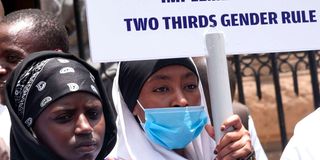Men's parliament or people's parliament? Inside Kenya's gender rule battle

What you need to know:
- The two-thirds gender rule was enshrined in the 2010 Constitution to ensure no more than two-thirds of any elective or appointive positions are held by one gender.
- Women's rights organisations, citing Parliament's failure to enact the necessary legislation, have petitioned Chief Justice Martha Koome to advise the president to dissolve Parliament.
- Despite women constituting over 50 per cent of Kenya's population and a taskforce report providing recommendations for implementation, the push for gender equality in leadership continues to face obstacles.
The recent Council of Governors (COG) elections reignited debates about gender representation in Kenya's leadership positions. Despite having seven women governors in the country, out of 47, only one - Machakos Governor Wavinya Ndeti - secured a position in the Council's recent elections. This outcome has raised questions about the implementation and understanding of Kenya's constitutional two-thirds gender rule.
What is the two-thirds gender rule?
Kenya's 2010 Constitution marked a watershed moment for women's rights in governance. At its core, the two-thirds gender rule stipulates that no more than two-thirds of members in any elective or appointive positions should be of the same gender. This principle is enshrined in several constitutional provisions, including Articles 27(8) and 81(b).
The rule wasn't created arbitrarily. It acknowledges a historical truth: women have been systematically marginalised in Kenya's political system. As the Constitution recognises, this marginalisation requires specific state intervention to guarantee equality rights.
Why does it matter?
The impact of gender inequality in leadership extends far beyond political representation. As demonstrated in the current situation, "the exclusion of women in the social, cultural and economic sphere is grounded in the unequal power structures particularly in leadership and decision making which contribute immensely towards reinforcing their exclusion in all other spheres."
This becomes particularly significant when considering that women constitute over 50 percent of Kenya's population, yet their representation in national and county leadership falls far short of this proportion.
Despite clear constitutional provisions, implementing the two-thirds gender rule has proven challenging. The biggest hurdle has been Parliament's failure to enact necessary legislation to implement this constitutional requirement.
This legislative gap led to a significant moment in September 2020, when former Chief Justice David Maraga advised then-President Uhuru Kenyatta to dissolve Parliament for failing to enact the required law. The advice, however, went unheeded.
Current push for implementation
Women's rights organisations have recently revived efforts to enforce the gender rule. A coalition of organisations, including CRAWN Trust, Centre for Rights Education and Awareness (Creaw), WeAre52pc and individual advocates.
These groups have petitioned Chief Justice Martha Koome to advise the president to dissolve Parliament over its continued failure to implement the rule.
In their petition, they argue that "the Supreme Court in the Advisory Opinions Applications 2 of 2012, determined that parliament was duty bound to pass the requisite legislation to implement the Constitution by August 2, 2015."
The organisations emphasise that "any act or omission in contravention of the constitution is invalid," and failing to issue an advisory on Parliament's dissolution would itself contravene the Constitution.
A multi-sectoral working group had previously developed recommendations for implementing the gender rule. However, according to CRAWN-Trust Executive Director Daisy Amdany, these efforts have been frustrated: "We handed the taskforce report to the former Public Service and Gender Cabinet Secretary Aisha Jumwa who in return handed it over to the Speaker of the National Assembly. It was thereafter supposed to be tabled on the floor of the House which never happened."
"When we try to find out about the progress we are asked which report and later told that it is missing," Amdany notes. "This clearly shows that people are playing games on women."
Looking forward
The push for implementing the two-thirds gender rule continues, with women's rights organisations maintaining pressure on government institutions. As Amdany emphasises, "We fully support calls for the dissolution of parliament since justice delayed is justice denied. Parliament must do its job as required by the constitution or go home. We have a legal basis to ask for its dissolution. We need women at the National Assembly as it is where laws are made."
The ongoing struggle to implement the two-thirds gender rule reflects a broader challenge in achieving gender equality in Kenya's governance structures. As the country continues to grapple with this issue, the outcome will significantly impact the future of democratic representation and gender equality in Kenya's leadership landscape.




